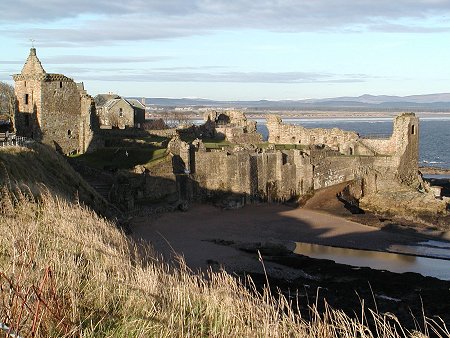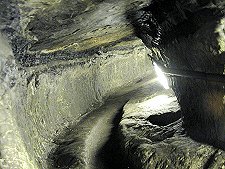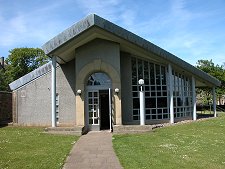
Best viewed in
Internet Explorer
PDF
Back to

Updated
07/08/2013 |
St. Andrew's Castle

We
are all probably familiar with the legendary St. Andrew’s golf course,
but before it was the course it was the castle grounds.
The
site was fortified by the 1100s, and from around 1200 it was adopted as
the main residence of the bishops and archbishops of St Andrews. As
such, the Castle became the principal administrative centre of the
Scottish Church and was the setting for some of the key events in
Scottish history.
Little of this early
Castle can be traced through the existing ruins. Certainly almost
nothing remains of the earliest structure which suffered badly during
the Wars of Independence and was finally rendered indefensible by the
Scots in 1337 to avoid it again being held again by the English.
 |
Completed in
about 1400, the "new" castle was the work of Bishop Trail.
With steep cliffs protecting it to the north and east, thick
curtain walls and rock cut ditches on its landward side it
was built to be easily defended.
The structure
of the castle included five square towers providing
residence for the bishop, his large household and guests.
Ranges were built along the inside of each length of curtain
wall and further accommodation was provided in outer
courtyards to the south and west of the main castle.
As a
residence, St Andrews Castle saw many notable visitors,
including the young James I who visited in 1410. The castle
also served as a strong and grim prison. An especially
striking remnant of this role is the bottle dungeon, a
bottle shaped pit dug 22ft down into the rock below the Sea
Tower and accessible only via the narrow neck opening
through a trap door from the floor of tower vault. Into this
prisoners could simply be lowered, or dropped, and
forgotten. David Stewart, 1st Duke of Rothesay was briefly
imprisoned here by his uncle, Robert Stewart, 1st Duke of
Albany, in 1401 before being taken to Falkland Palace and,
probably, starved to death.
Further
significant work on the castle was undertaken by Archbishop
James Beaton following the Battle of Flodden in 1513. This
was designed to allow the structure withstand an attack by
heavy artillery. Two massive circular gun towers, called
blockhouses, were built on the landward side and heavy
carriage-mounted guns were positioned at the wall tops. |
Beaton appointed as
his successor his nephew David Beaton, an ambitious man who later
became a Cardinal and a prominent figure in both the religious and
political life of Scotland: despite being in all but name married to
Marion Ogilvy. It was Cardinal Beaton's strong opposition to the
marriage of the infant Mary, Queen of Scots to Prince Edward, son
and heir of Henry VIII of England that led to renewed warfare
between the two countries in 1544.
Not satisfied with
this, in March 1546, he had the Protestant preacher, George Wishart,
burnt at the stake in front of the castle walls. This was
subsequently used as a pretext for Beaton's grisly murder at the
hands of local Protestant lairds who captured the castle by stealth.
A
long siege followed on the orders of the Regent, the Earl of Arran.
By November 1546 this had resulted in a stalemate and the attackers
resorted to an approach that has left what is today St Andrews
Castle's second most chilling underground artifact after the bottle
dungeon: the mine.
 |
The
besiegers sought to undermine the walls of the castle by
digging a spacious tunnel large enough to take pack
animals who were used to carry out the spoil. The
defenders responded to the mine by trying to dig an
intercepting tunnel or countermine. After several false
starts the defenders' low, narrow, twisting countermine
broke through into the attackers' mine, resulting in
underground fighting between the two sides. Today's
visitors are able to make their way down the countermine
and into the mine, though it's not somewhere for those
with claustrophobia or an overly active imagination.
The siege
was eventually settled, decisively, in 1547 with the
arrival of a French fleet which reduced the castle to
ruins. Amongst those captured when the castle fell was
John Knox.
St
Andrews Castle passed next to the illegitimate brother
of the Regent Earl of Arran, Archbishop John Hamilton.
Although finally hanged after he was implicated in the
death of Lord Darnley, he was able to rebuild most of
the castle. The results were a much more grand and
elaborate structure than the fortress it replaced. |
The Reformation
of the Scottish Church in 1560 had little immediate effect on
the castle and its operation, but over time it became
increasingly neglected. Its association with the church seemed
permanently severed in 1606 when it passed to the Earl of
Dunbar, but it did later return to church control before finally
falling into ruin after the ascendancy of William and Mary in
1689.

To the modern
visitor, St Andrews Castle shows the scars of the centuries of
decay since its abandonment. But it is still possible to get a
sense of grandeur here and view the unusual features that have
survived. There is also an excellent visitors' centre.
|




